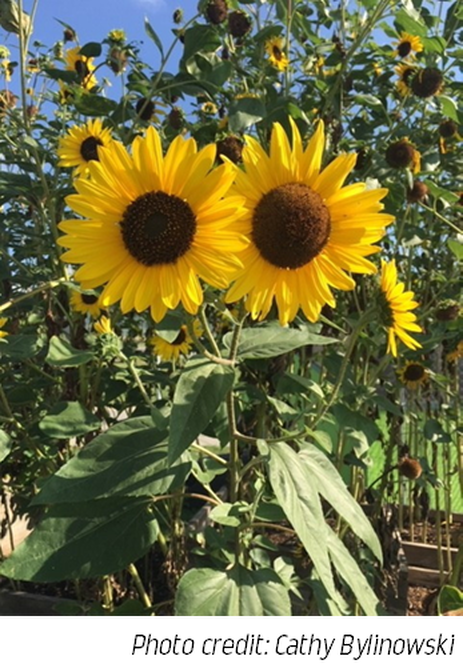|
|
by Cathy Bylinowski, Horticulture Instructor, University of Missouri Extension Here are some gardening tips from University of Missouri Extension Horticulture faculty to help you get through July and summer with some color in your flower beds, with healthy trees and lawns, and some tasty crops from your vegetable garden:
Outdoor flowering plants and ornamentals Deadhead annuals and perennials, if reseeding is not desired, to encourage branching and blooms. Look for diseased foliage on roses. Practice sanitation and clean up any fallen leaves. Watch for distorted growth and abnormal looking blooms that might indicate rose rosette disease. Newly planted trees and shrubs should continue to be watered thoroughly at least once a week if regular rains are not occurring. Monitor trees and shrubs for Japanese beetles. For more information visit: https://ipm.missouri.edu/pestmonitoring/jb/ Divide iris after bloom. Enjoy beautiful bouquets of flowers from your garden! Water newly planted trees and shrubs thoroughly, once a week. Keep up with weeding. Do not let weeds go to seed. Do not fertilize trees and shrubs after July 4th to prevent new growth that may lead to winter injury. Vegetable Gardening Blossom-end rot of tomato and peppers occurs when soil moisture is irregular or uneven. Mulch plants to discourage this problem. Irrigate regularly during dry weather and mulch sufficiently around vegetable plants to conserve the moisture. Water at the base of plants to keep foliage dry to help prevent diseases in the garden. Dig potatoes when tops die. Pull onions when tops fall over and start to turn brown. Harvest garlic when about 1/2 of the leaves turn yellow. Dry in a ventilated area and store in a cool, dry place. for more information, see MU Extension Guide g6226 Vegetable Harvest and Storage https://extension2.missouri.edu/g6226. Make successive plantings of corn, beans, cucumbers and summer squash to be able to harvest into fall. Scout for insect and disease problems in the garden. Many pests can be controlled with a strong blast of water from the hose or by hand picking and squashing. If you use a biological or conventional pesticide, read and carefully follow directions on label. For information about plant diseases, see MU extension guide g6203 Common Diseases in the Home Garden https://extension2.missouri.edu/g6203. After harvesting ripe tomatoes, they can be stored between 55 to 60 degrees F up to one week. Fertilize established plantings of rhubarb and asparagus. Keep ahead of the weeds. Fruits and Nut trees Prune out and destroy old fruiting canes of raspberries and blackberries after harvest is complete. Watch for diseased canes and plants. Blackberries are starting to ripen. Get ready for picking!! Scout peach trees for brown rot. A preventative spray schedule can keep disease and insects at bay. For more information, see MU extension guide Fruit Spray Schedules for the Homeowner https://extension2.missouri.edu/g6010. To keep birds away from fruit trees, try different scare tactics like fake snakes, owls, scare crows, pie pans, old CDs, and wind chimes. June bearing strawberries need summer care. If you have your plants in hills, pick off all runners. If you planted a matted row, encourage the runners to root and grow until the row is 2 feet wide. Early season peach, pear and apple variety harvest begins. Cool season lawns Tall fescue and/or Kentucky bluegrass Restrict heavy nitrogen fertilization on cool-season lawns in July in Missouri. At most, 0.5 lb. N per 1000 sq ft could be used on nitrogen starved cool-season lawns. Water if needed. Water infrequently to a depth of 4-6 inches. Avoid puddles and runoff. Don't overwater, as that can promote fungal growth. This is worse than having some drought stress. Tall fescue can undergo some drought stress and recover. For more information, see MU extension guide g6705 Cool-season Grasses: Lawn Maintenance Calendar https://extension2.missouri.edu/g6705. Rapidly growing lawns need frequent mowing. Taller mowing heights of about 3 1/2 to 4 inches reduce the chance for turf scalping. Mulch clippings. Only remove if they are excessive and cover the turf canopy. Warm Season Lawns Zoysiagrass Fertilize lawn at 0.5 lb nitrogen (N) per 1000 sq ft. Mow at 1-2 inches height frequently, approximately once a week. Zoysiagrass is drought tolerant. Watering should not be necessary except for prolonged dry periods. Contact MU Extension in Jackson County, 816-252-5051, for more gardening information. Comments are closed.
|
Categories
All
Archives
July 2024
|
Grain Valley NewsGrain Valley News is a free community news source published weekly online. |
Contact Us |



 RSS Feed
RSS Feed
